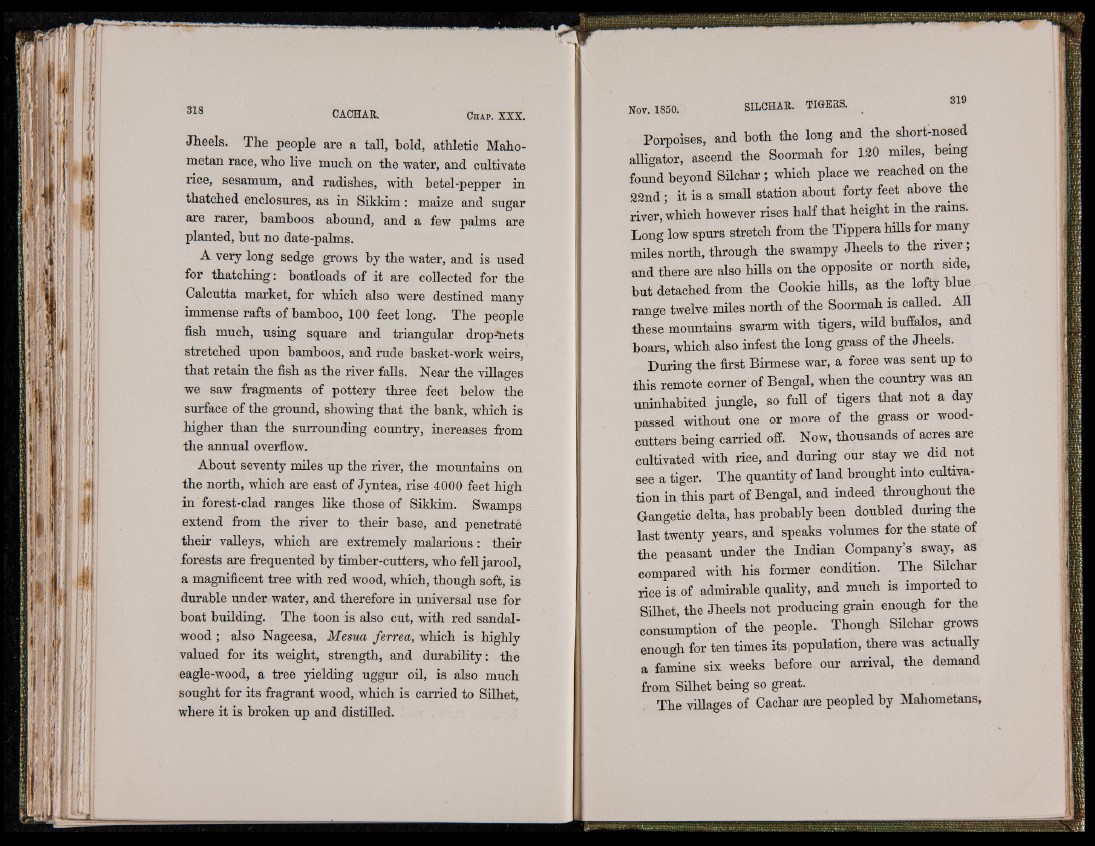
Jheels. The people are a tall, bold, athletic Mahometan
race, who live much on the water, and cultivate
rice, sesamum, and radishes, with betel-pepper in
thatched enclosures, as in Sikkim: maize and sugar
are rarer, bamboos abound, and a few palms are
planted, but no date-palms.
A very long sedge grows by the water, and is used
for thatching: boatloads of it are collected for the
Calcutta market, for which also were destined many
immense rafts of bamboo, 100 feet long. The people
fish much, using square and triangular drop-*aets
stretched upon bamboos, and rude basket-work weirs,
that retain the fish as the river falls. Near the villages
we saw fragments of pottery three feet below the
surface of the ground, showing that the bank, which is
higher than the surrounding country, increases from
the annual overflow.
About seventy miles up the river, the mountains on
the north, which are east of Jyntea, rise 4000 feet high
in forest-clad ranges like those of Sikkim. Swamps
extend from the river to their base, and penetrate
their valleys, which are extremely malarious : their
forests are frequented by timber-cutters, who felljarool,
a magnificent tree with red wood, which, though soft, is
durable under water, and therefore in universal use for
boat building. The toon is also cut, with red sandalwood
; also Nageesa, Mesua ferrea, which is highly
valued for its weight, strength, and durability: the
eagle-wood, a tree yielding uggur oil, is also much
sought for its fragrant wood, which is carried to Silhet,
where it is broken up and distilled.
Porpoises, and both the long and the short-nosed
alligator, ascend the Soormah for 120 miles, bemg
found beyond Silchar; which place we reached on the
22nd; it is a small station about forty feet above the
river, which however rises half that height in the rains.
Long low spurs stretch from the Tippera hills for many
miles north, through the swampy Jheels to the riv e r;
and there are also hills on the opposite or north side,
but detached from the Cookie hills, as tiie lofty blue
range twelve miles north of the Soormah is called. All
these mountains swarm with tigers, wild buffalos, and
boars, which also infest the long grass of the Jheels.
During the first Birmese war, a force was sent up to
this remote corner of Bengal, when the country was an
uninhabited jungle, so full of tigers that not a day
passed without one or more of the grass or woodcutters
being carried off. Now, thousands of acres are
cultivated with rice, and during our stay we did not
see a tiger. The quantity of land brought into cultivation
in this part of Bengal, and indeed throughout the
Gangetic delta, has probably been doubled during the
last twenty years, and speaks volumes for the state of
the peasant under the Indian Company’s sway, as
compared with his former condition. The Silchar
rice is of admirable quality, and much is imported to
gilhet, the Jheels not producing grain enough for the
consumption of the people. Though Silchar grows
enough for ten times its population, there was actually
a famine six weeks before our arrival, the demand
from Silhet being so great.
The villages of Cachar are peopled by Mahometans,